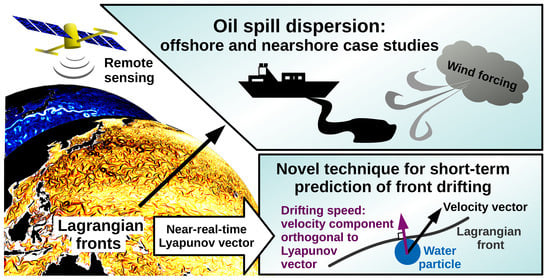Drifting Speed of Lagrangian Fronts and Oil Spill Dispersal at the Ocean Surface
Abstract
:1. Introduction
2. Materials and Methods
2.1. The East China Sea Oil Spill
2.2. The East Mediterranean Oil Spill
2.3. Oil Slick Detection
2.4. Satellite Observations and Numerical Models
2.4.1. Global Current Velocities
2.4.2. Mediterranean Current Velocities
2.4.3. Surface Wind Velocities and Current-Wind Mixed Product
2.5. Lagrangian Advection and Derived Trajectories
2.6. Lagrangian Fronts Detection by the Lyapunov Exponent
2.7. Estimating the Drifting Speed of a Lagrangian Front
2.8. Sea Surface Temperature
3. Results
3.1. Lagrangian Advection of Virtual Numerical Tracer vs. East China Sea Oil Imaging
3.2. Regional Application of Lagrangian Fronts on East China Sea Pollution: Offshore Dynamics
3.3. Regional Application of Lagrangian Fronts on the East Mediterranean Pollution: Coastal Dynamics and Strong Wind
3.4. Prediction of the Lagrangian Front Drifting Speed
3.4.1. Front Drifting Speed in the Area of the East China Sea Oil Spill
3.4.2. Front Drifting Speed in the Area of the East Mediterranean Oil Spill
3.5. Fronts Drift and SST Patterns
4. Discussion
5. Conclusions
Author Contributions
Funding
Data Availability Statement
Acknowledgments
Conflicts of Interest
Appendix A
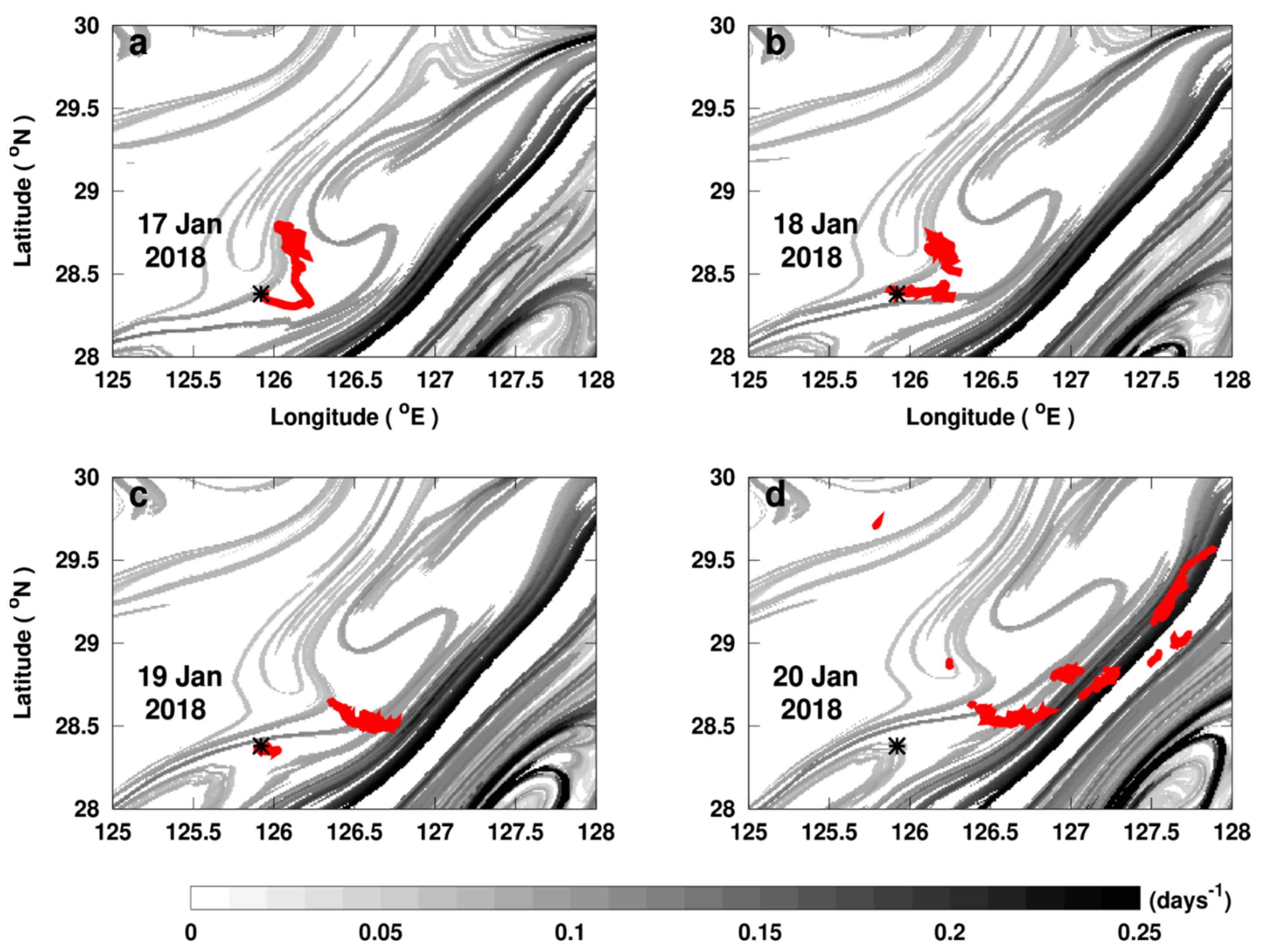


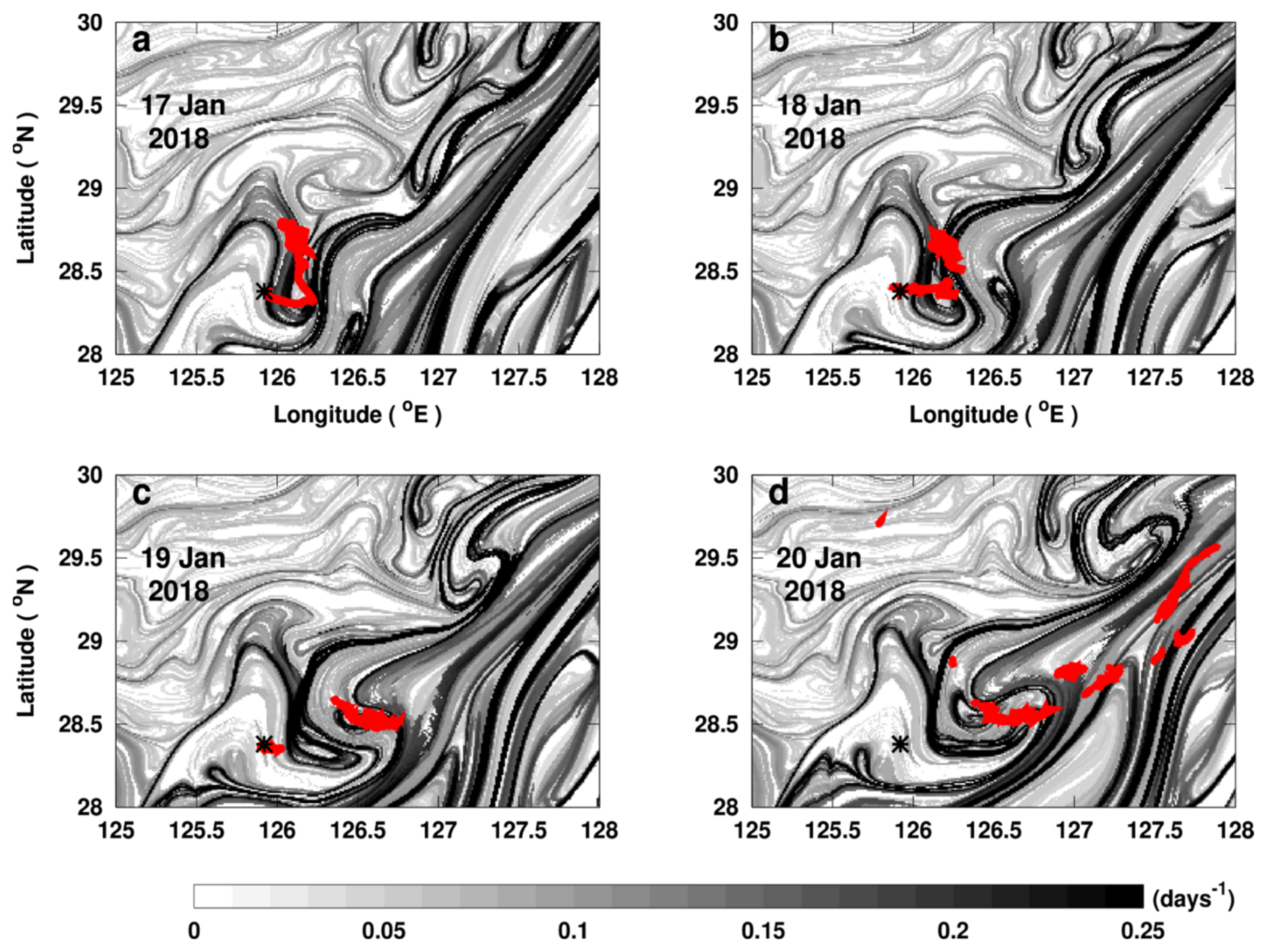

References
- Rathore, S.S.; Chandravanshi, P.; Chandravanshi, A.; Jaiswal, K. Eutrophication: Impacts of Excess Nutrient Inputs on Aquatic Ecosystem. IOSR 2016, 9, 89–96. [Google Scholar] [CrossRef]
- Wurtsbaugh, W.A.; Paerl, H.W.; Dodds, W.K. Nutrients, Eutrophication and Harmful Algal Blooms along the Freshwater to Marine Continuum. WIREs Water 2019, 6, e1373. [Google Scholar] [CrossRef]
- Ma, Y.; Halsall, C.J.; Crosse, J.D.; Graf, C.; Cai, M.; He, J.; Gao, G.; Jones, K. Persistent Organic Pollutants in Ocean Sediments from the N orth P acific to the Arctic O cean. J. Geophys. Res. Oceans 2015, 120, 2723–2735. [Google Scholar] [CrossRef] [Green Version]
- Michel, J.; Fingas, M. Oil Spills: Causes, Consequences, Prevention, and Countermeasures. In World Scientific Series in Current Energy Issues; World Scientific: Singapore, 2016; Volume 1, pp. 159–201. ISBN 978-981-4699-97-6. [Google Scholar]
- Furness, R.W.; Rainbow, P.S. Heavy Metals in the Marine Environment; CRC Press: Boca Raton, FL, USA, 2018; ISBN 978-1-351-07315-8. [Google Scholar]
- Szefer, P. Metal Pollutants and Radionuclides in the Baltic Sea—An Overview. Oceanologia 2002, 44, 129–178. [Google Scholar]
- Prants, S.V.; Budyansky, M.V.; Uleysky, M.Y. Lagrangian Study of Surface Transport in the Kuroshio Extension Area Based on Simulation of Propagation of Fukushima-Derived Radionuclides. Nonlinear Processes Geophys. 2014, 21, 279–289. [Google Scholar] [CrossRef] [Green Version]
- Ramirez-Llodra, E.; De Mol, B.; Company, J.B.; Coll, M.; Sardà, F. Effects of Natural and Anthropogenic Processes in the Distribution of Marine Litter in the Deep Mediterranean Sea. Progress Oceanogr. 2013, 118, 273–287. [Google Scholar] [CrossRef]
- Islam, S.; Tanaka, M. Impacts of Pollution on Coastal and Marine Ecosystems Including Coastal and Marine Fisheries and Approach for Management: A Review and Synthesis. Mar. Pollut. Bull. 2004, 48, 624–649. [Google Scholar] [CrossRef] [PubMed]
- Worm, B.; Lotze, H.K.; Jubinville, I.; Wilcox, C.; Jambeck, J. Plastic as a Persistent Marine Pollutant. Annu. Rev. Environ. Resour. 2017, 42, 1–26. [Google Scholar] [CrossRef]
- Sumaila, U.R.; Cisneros-Montemayor, A.M.; Dyck, A.; Huang, L.; Cheung, W.; Jacquet, J.; Kleisner, K.; Lam, V.; McCrea-Strub, A.; Swartz, W.; et al. Impact of the Deepwater Horizon Well Blowout on the Economics of US Gulf Fisheries. Can. J. Fish. Aquat. Sci. 2012, 69, 499–510. [Google Scholar] [CrossRef] [Green Version]
- Beaumont, N.J.; Aanesen, M.; Austen, M.C.; Börger, T.; Clark, J.R.; Cole, M.; Hooper, T.; Lindeque, P.K.; Pascoe, C.; Wyles, K.J. Global Ecological, Social and Economic Impacts of Marine Plastic. Mar. Pollut. Bull. 2019, 142, 189–195. [Google Scholar] [CrossRef]
- Danabasoglu, G.; McWilliams, J.C.; Gent, P.R. The Role of Mesoscale Tracer Transports in the Global Ocean Circulation. Science 1994, 264, 1123–1126. [Google Scholar] [CrossRef] [PubMed]
- D’ovidio, F.; Della Penna, A.; Trull, T.W.; Nencioli, F.; Pujol, M.-I.; Rio, M.-H.; Park, Y.-H.; Cotté, C.; Zhou, M.; Blain, S. The Biogeochemical Structuring Role of Horizontal Stirring: Lagrangian Perspectives on Iron Delivery Downstream of the Kerguelen Plateau. Biogeosciences 2015, 12, 5567–5581. [Google Scholar] [CrossRef] [Green Version]
- García-Olivares, A.; Isern-Fontanet, J.; García-Ladona, E. Dispersion of Passive Tracers and Finite-Scale Lyapunov Exponents in the Western Mediterranean Sea. Deep Sea Res. Part I Oceanogr. Res. Pap. 2007, 54, 253–268. [Google Scholar] [CrossRef]
- Baudena, A.; Ser-Giacomi, E.; López, C.; Hernández-García, E.; d’Ovidio, F. Crossroads of the Mesoscale Circulation. J. Mar. Syst. 2019, 192, 1–14. [Google Scholar] [CrossRef] [Green Version]
- Musa, Z.N.; Popescu, I.; Mynett, A. A Review of Applications of Satellite SAR, Optical, Altimetry and DEM Data for Surface Water Modelling, Mapping and Parameter Estimation. Hydrol. Earth Syst. Sci. 2015, 19, 3755–3769. [Google Scholar] [CrossRef] [Green Version]
- Haza, A.C.; Özgökmen, T.M.; Griffa, A.; Garraffo, Z.D.; Piterbarg, L. Parameterization of Particle Transport at Submesoscales in the Gulf Stream Region Using Lagrangian Subgridscale Models. Ocean Model. 2012, 42, 31–49. [Google Scholar] [CrossRef]
- Prants, S.V.; Uleysky, M.Y.; Budyansky, M.V. Lagrangian Coherent Structures in the Ocean Favorable for Fishery. Dokl. Earth Sci. 2012, 447, 1269–1272. [Google Scholar] [CrossRef]
- Gildor, H.; Fredj, E.; Steinbuck, J.; Monismith, S. Evidence for Submesoscale Barriers to Horizontal Mixing in the Ocean from Current Measurements and Aerial Photographs. J. Phys. Oceanogr. 2009, 39, 1975–1983. [Google Scholar] [CrossRef]
- McWilliams, J.C. Submesoscale Currents in the Ocean. Proc. R. Soc. A 2016, 472, 20160117. [Google Scholar] [CrossRef]
- Van Sebille, E.; Griffies, S.M.; Abernathey, R.; Adams, T.P.; Berloff, P.; Biastoch, A.; Blanke, B.; Chassignet, E.P.; Cheng, Y.; Cotter, C.J.; et al. Lagrangian Ocean Analysis: Fundamentals and Practices. Ocean Model. 2018, 121, 49–75. [Google Scholar] [CrossRef]
- Boffetta, G.; Lacorata, G.; Redaelli, G.; Vulpiani, A. Detecting Barriers to Transport: A Review of Different Techniques. Phys. D Nonlinear Phenom. 2001, 159, 58–70. [Google Scholar] [CrossRef] [Green Version]
- Haller, G.; Yuan, G. Lagrangian Coherent Structures and Mixing in Two-Dimensional Turbulence. Phys. D Nonlinear Phenom. 2000, 147, 352–370. [Google Scholar] [CrossRef]
- Lehahn, Y.; d’Ovidio, F.; Koren, I. A Satellite-Based Lagrangian View on Phytoplankton Dynamics. Annu. Rev. Mar. Sci. 2018, 10, 99–119. [Google Scholar] [CrossRef] [Green Version]
- Olascoaga, M.J.; Haller, G. Forecasting Sudden Changes in Environmental Pollution Patterns. Proc. Natl. Acad. Sci. USA 2012, 109, 4738–4743. [Google Scholar] [CrossRef] [PubMed] [Green Version]
- Duran, R.; Beron-Vera, F.J.; Olascoaga, M.J. Extracting Quasi-Steady Lagrangian Transport Patterns from the Ocean Circulation: An Application to the Gulf of Mexico. Sci. Rep. 2018, 8, 5218. [Google Scholar] [CrossRef] [PubMed] [Green Version]
- Sun, S.; Lu, Y.; Liu, Y.; Wang, M.; Hu, C. Tracking an Oil Tanker Collision and Spilled Oils in the East China Sea Using Multisensor Day and Night Satellite Imagery. Geophys. Res. Lett. 2018, 45, 3212–3220. [Google Scholar] [CrossRef]
- Yin, L.; Zhang, M.; Zhang, Y.; Qiao, F. The Long-Term Prediction of the Oil-Contaminated Water from the Sanchi Collision in the East China Sea. Acta Oceanol. Sin. 2018, 37, 69–72. [Google Scholar] [CrossRef]
- Amir-Heidari, P.; Raie, M. Response Planning for Accidental Oil Spills in Persian Gulf: A Decision Support System (DSS) Based on Consequence Modeling. Mar. Pollut. Bull. 2019, 140, 116–128. [Google Scholar] [CrossRef]
- Pan, Q.; Yu, H.; Daling, P.S.; Zhang, Y.; Reed, M.; Wang, Z.; Li, Y.; Wang, X.; Wu, L.; Zhang, Z.; et al. Fate and Behavior of Sanchi Oil Spill Transported by the Kuroshio during January–February 2018. Mar. Pollut. Bull. 2020, 152, 110917. [Google Scholar] [CrossRef] [PubMed]
- Gallagher, S.J.; Kitamura, A.; Iryu, Y.; Itaki, T.; Koizumi, I.; Hoiles, P.W. The Pliocene to Recent History of the Kuroshio and Tsushima Currents: A Multi-Proxy Approach. Prog. Earth Planet. Sci. 2015, 2, 17. [Google Scholar] [CrossRef] [Green Version]
- Abdulla, A.; Linden, O. Maritime Traffic Effects on Biodiversity in the Mediterranean Sea: Review of Impacts, Priority Areas and Mitigation Measures; IUCN: Gland, Switzerland, 2008; ISBN 978-2-8317-1079-2. [Google Scholar]
- Coomber, F.G.; D’Incà, M.; Rosso, M.; Tepsich, P.; di Sciara, G.N.; Moulins, A. Description of the Vessel Traffic within the North Pelagos Sanctuary: Inputs for Marine Spatial Planning and Management Implications within an Existing International Marine Protected Area. Mar. Policy 2016, 69, 102–113. [Google Scholar] [CrossRef]
- Bonanno, A.; Zgozi, S.W.; Jarboui, O.; Mifsud, R.; Ceriola, L.; Basilone, G.; Arneri, E. Marine Ecosystems and Living Resources in the Central Mediterranean Sea: An Introduction. Hydrobiologia 2018, 821, 1–10. [Google Scholar] [CrossRef] [Green Version]
- Marangoni, C. Sul principio della viscosita’ superficiale dei liquidi stabilito dalsig. J. Plateau. Nuovo Cimento 1871, 5–6, 239–273. [Google Scholar] [CrossRef]
- Alpers, W.; Hühnerfuss, H. Radar Signatures of Oil Films Floating on the Sea Surface and the Marangoni Effect. J. Geophys. Res. 1988, 93, 3642. [Google Scholar] [CrossRef]
- Jackson, C.R.; Apel, J.R. Synthetic Aperture Radar: Marine User’s Manual; U.S. Dept. of Commerce, National Oceanic and Atmospheric Administration, National Environmental Satellite, Data, and Information Service, Office of Research and Applications: Washington, DC, USA, 2004; ISBN 978-0-16-073214-0.
- Girard-Ardhuin, F.; Mercier, G.; Collard, F.; Garello, R. Operational Oil-Slick Characterization by SAR Imagery and Synergistic Data. IEEE J. Ocean. Eng. 2005, 30, 487–495. [Google Scholar] [CrossRef] [Green Version]
- Press, W.H.; Teukolsky, S.A.; Flannery, B.P.; Vetterling, W.T. Numerical Recipes in Fortran 77: Volume 1, Volume 1 of Fortran Numerical Recipes: The Art of Scientific Computing; Cambridge University Press: Cambridge, UK, 1992; ISBN 978-0-521-43108-8. [Google Scholar]
- Abraham, E.R.; Law, C.S.; Boyd, P.W.; Lavender, S.J.; Maldonado, M.T.; Bowie, A.R. Importance of Stirring in the Development of an Iron-Fertilized Phytoplankton Bloom. Nature 2000, 407, 727–730. [Google Scholar] [CrossRef]
- D’Ovidio, F.; Fernández, V.; Hernández-García, E.; López, C. Mixing Structures in the Mediterranean Sea from Finite-Size Lyapunov Exponents. Geophys. Res. Lett. 2004, 31, L17203. [Google Scholar] [CrossRef] [Green Version]
- Haller, G. Lagrangian Coherent Structures. Annu. Rev. Fluid Mech. 2015, 47, 137–162. [Google Scholar] [CrossRef] [Green Version]
- Ott, E. Chaos in Dynamical Systems; Cambridge University Press: Cambridge, UK; New York, NY, USA, 2002; ISBN 978-0-521-81196-5. [Google Scholar]
- Koh, T.-Y.; Legras, B. Hyperbolic Lines and the Stratospheric Polar Vortex. Chaos 2002, 12, 382–394. [Google Scholar] [CrossRef]
- Pierrehumbert, R.T.; Yang, H. Global Chaotic Mixing on Isentropic Surfaces. J. Atmos. Sci. 1993, 50, 2462–2480. [Google Scholar] [CrossRef] [Green Version]
- Tél, T.; de Moura, A.; Grebogi, C.; Károlyi, G. Chemical and Biological Activity in Open Flows: A Dynamical System Approach. Phys. Rep. 2005, 413, 91–196. [Google Scholar] [CrossRef]
- D’Ovidio, F.; Shuckburgh, E.; Legras, B. Local Mixing Events in the Upper Troposphere and Lower Stratosphere. Part I: Detection with the Lyapunov Diffusivity. J. Atmos. Sci. 2009, 66, 3678–3694. [Google Scholar] [CrossRef]
- Bettencourt, J.H.; López, C.; Hernández-García, E.; Montes, I.; Sudre, J.; Dewitte, B.; Paulmier, A.; Garçon, V. Boundaries of the Peruvian Oxygen Minimum Zone Shaped by Coherent Mesoscale Dynamics. Nat. Geosci. 2015, 8, 937–940. [Google Scholar] [CrossRef] [Green Version]
- Hernández-Carrasco, I.; López, C.; Hernández-García, E.; Turiel, A. Seasonal and Regional Characterization of Horizontal Stirring in the Global Ocean. J. Geophys. Res. 2012, 117, C10007. [Google Scholar] [CrossRef] [Green Version]
- Rossi, V.; López, C.; Sudre, J.; Hernández-García, E.; Garçon, V. Comparative Study of Mixing and Biological Activity of the Benguela and Canary Upwelling Systems. Geophys. Res. Lett. 2008, 35, L11602. [Google Scholar] [CrossRef] [Green Version]
- Della Penna, A.; Koubbi, P.; Cotté, C.; Bon, C.; Bost, C.-A.; d’Ovidio, F. Lagrangian Analysis of Multi-Satellite Data in Support of Open Ocean Marine Protected Area Design. Deep Sea Res. Part II Top. Stud. Oceanogr. 2017, 140, 212–221. [Google Scholar] [CrossRef]
- Bettencourt, J.H.; Rossi, V.; Hernández-García, E.; Marta-Almeida, M.; López, C. Characterization of the Structure and Cross-shore Transport Properties of a Coastal Upwelling Filament Using Three-dimensional Finite-size Lyapunov Exponents. J. Geophys. Res. Oceans 2017, 122, 7433–7448. [Google Scholar] [CrossRef] [Green Version]
- Shadden, S.C.; Lekien, F.; Marsden, J.E. Definition and Properties of Lagrangian Coherent Structures from Finite-Time Lyapunov Exponents in Two-Dimensional Aperiodic Flows. Phys. D Nonlinear Phenom. 2005, 212, 271–304. [Google Scholar] [CrossRef]
- Haller, G. A Variational Theory of Hyperbolic Lagrangian Coherent Structures. Phys. D Nonlinear Phenom. 2011, 240, 574–598. [Google Scholar] [CrossRef]
- Barceló-Llull, B.; Pascual, A.; Sánchez-Román, A.; Cutolo, E.; d’Ovidio, F.; Fifani, G.; Ser-Giacomi, E.; Ruiz, S.; Mason, E.; Cyr, F.; et al. Fine-Scale Ocean Currents Derived From in Situ Observations in Anticipation of the Upcoming SWOT Altimetric Mission. Front. Mar. Sci. 2021, 8, 679844. [Google Scholar] [CrossRef]
- Baaklini, G.; Issa, L.; Fakhri, M.; Brajard, J.; Fifani, G.; Menna, M.; Taupier-Letage, I.; Bosse, A.; Mortier, L. Blending Drifters and Altimetric Data to Estimate Surface Currents: Application in the Levantine Mediterranean and Objective Validation with Different Data Types. Ocean Model. 2021, 166, 101850. [Google Scholar] [CrossRef]
- Cipollini, P.; Vignudelli, S.; Benveniste, J. The Coastal Zone: A Mission Target for Satellite Altimeters: Summary of the 7th Coastal Altimetry Workshop; Boulder, Colorado, 7–8 October 2013. Eos Trans. AGU 2014, 95, 72. [Google Scholar] [CrossRef] [Green Version]
- Ballarotta, M.; Ubelmann, C.; Pujol, M.-I.; Taburet, G.; Fournier, F.; Legeais, J.-F.; Faugère, Y.; Delepoulle, A.; Chelton, D.; Dibarboure, G.; et al. On the Resolutions of Ocean Altimetry Maps. Ocean Sci. 2019, 15, 1091–1109. [Google Scholar] [CrossRef] [Green Version]
- Vignudelli, S.; Birol, F.; Benveniste, J.; Fu, L.-L.; Picot, N.; Raynal, M.; Roinard, H. Satellite Altimetry Measurements of Sea Level in the Coastal Zone. Surv. Geophys. 2019, 40, 1319–1349. [Google Scholar] [CrossRef]
- Forth, H.P.; Mitchelmore, C.L.; Morris, J.M.; Lipton, J. Characterization of Oil and Water Accommodated Fractions Used to Conduct Aquatic Toxicity Testing in Support of the Deepwater Horizon Oil Spill Natural Resource Damage Assessment: Characterization of Oil and Water Accommodated Fractions. Environ. Toxicol. Chem. 2017, 36, 1450–1459. [Google Scholar] [CrossRef] [PubMed]
- Drouin, K.L.; Mariano, A.J.; Ryan, E.H.; Laurindo, L.C. Lagrangian Simulation of Oil Trajectories in the Florida Straits. Mar. Pollut. Bull. 2019, 140, 204–218. [Google Scholar] [CrossRef]
- Soto, L.A.; Botello, A.V.; Licea-Durán, S.; Lizárraga-Partida, M.L.; Yáñez-Arancibia, A. The Environmental Legacy of the Ixtoc-I Oil Spill in Campeche Sound, Southwestern Gulf of Mexico. Front. Mar. Sci. 2014, 1, 1–9. [Google Scholar] [CrossRef] [Green Version]
- Carswell, C. Unique Oil Spill in East China Sea Frustrates Scientists. Nature 2018, 554, 17–19. [Google Scholar] [CrossRef] [Green Version]
- Sundermeyer, M.A.; Price, J.F. Lateral Mixing and the North Atlantic Tracer Release Experiment: Observations and Numerical Simulations of Lagrangian Particles and a Passive Tracer. J. Geophys. Res. 1998, 103, 21481–21497. [Google Scholar] [CrossRef] [Green Version]
- Baudena, A.; Ser-Giacomi, E.; D’Onofrio, D.; Capet, X.; Cotté, C.; Cherel, Y.; D’Ovidio, F. Fine-Scale Structures as Spots of Increased Fish Concentration in the Open Ocean. Sci. Rep. 2021, 11, 15805. [Google Scholar] [CrossRef]
- Ledwell, J.R.; Watson, A.J.; Law, C.S. Mixing of a Tracer in the Pycnocline. J. Geophys. Res. 1998, 103, 21499–21529. [Google Scholar] [CrossRef]
- Nencioli, F.; d’Ovidio, F.; Doglioli, A.M.; Petrenko, A.A. In Situ Estimates of Submesoscale Horizontal Eddy Diffusivity across an Ocean Front. J. Geophys. Res. Oceans 2013, 118, 7066–7080. [Google Scholar] [CrossRef] [Green Version]
- Morrow, R.; Fu, L.-L.; Ardhuin, F.; Benkiran, M.; Chapron, B.; Cosme, E.; d’Ovidio, F.; Farrar, J.T.; Gille, S.T.; Lapeyre, G.; et al. Global Observations of Fine-Scale Ocean Surface Topography With the Surface Water and Ocean Topography (SWOT) Mission. Front. Mar. Sci. 2019, 6, 232. [Google Scholar] [CrossRef]
- d’Ovidio, F.; Pascual, A.; Wang, J.; Doglioli, A.M.; Jing, Z.; Moreau, S.; Grégori, G.; Swart, S.; Speich, S.; Cyr, F.; et al. Frontiers in Fine-Scale in Situ Studies: Opportunities During the SWOT Fast Sampling Phase. Front. Mar. Sci. 2019, 6, 168. [Google Scholar] [CrossRef]
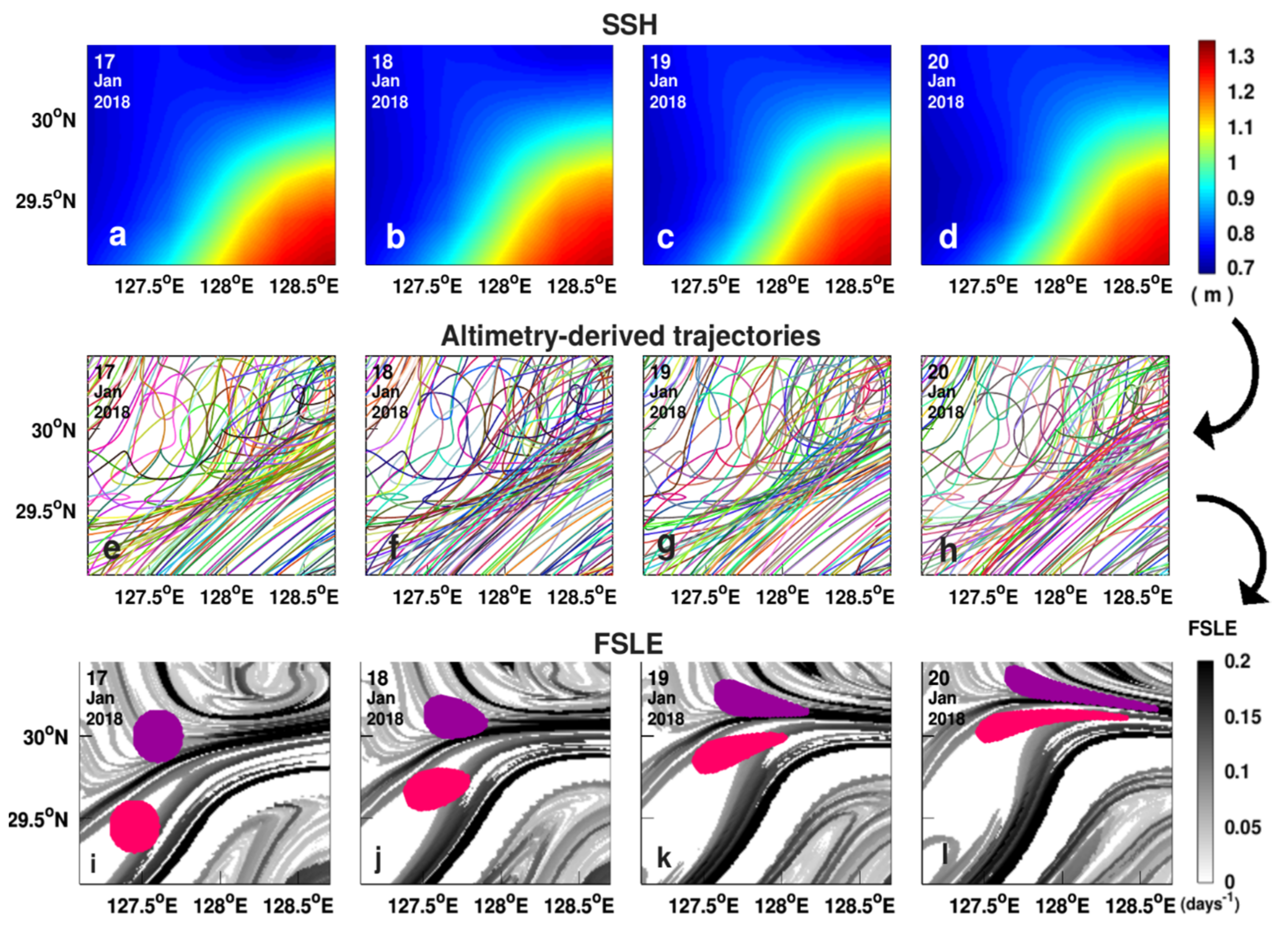
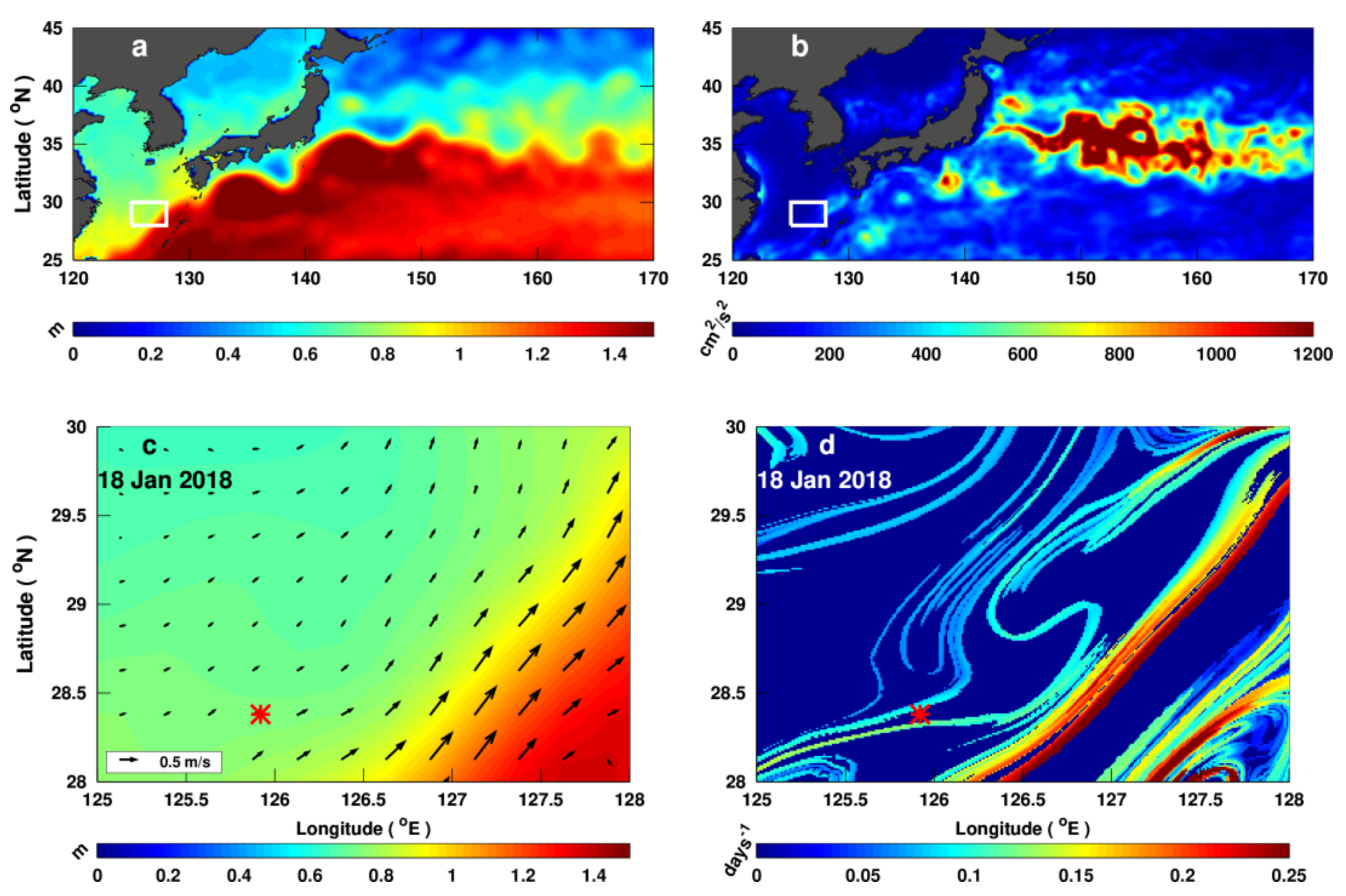
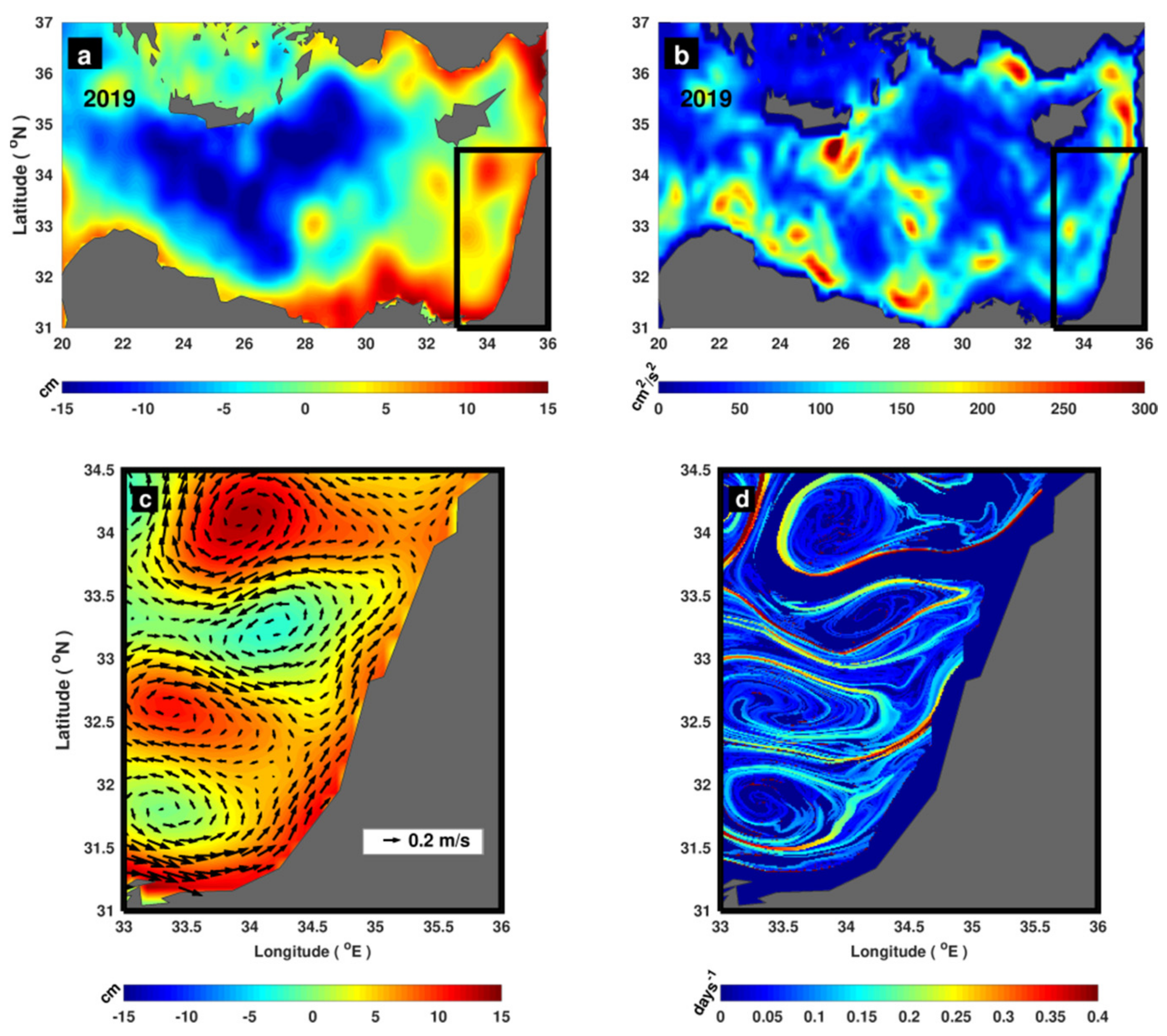


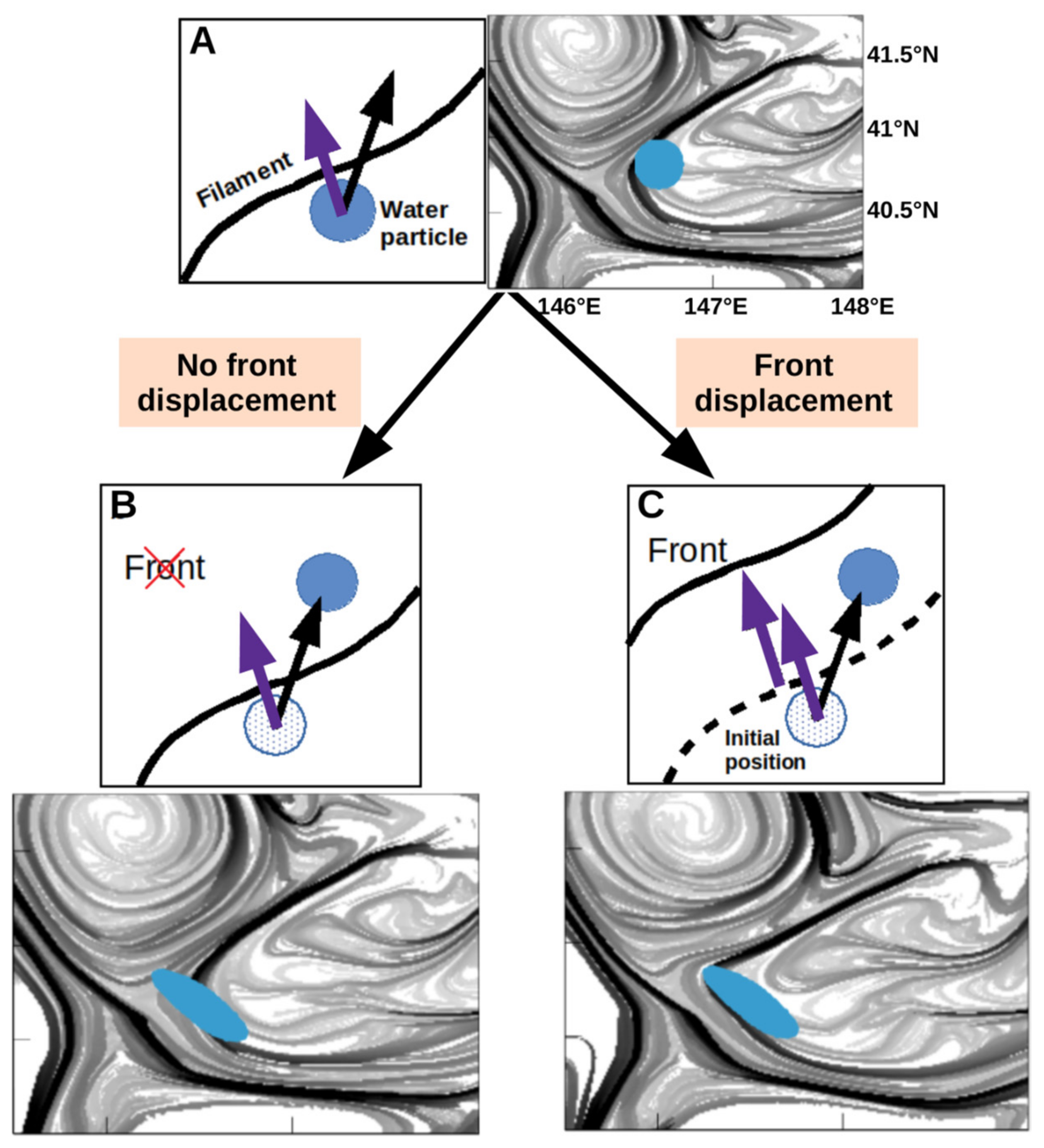
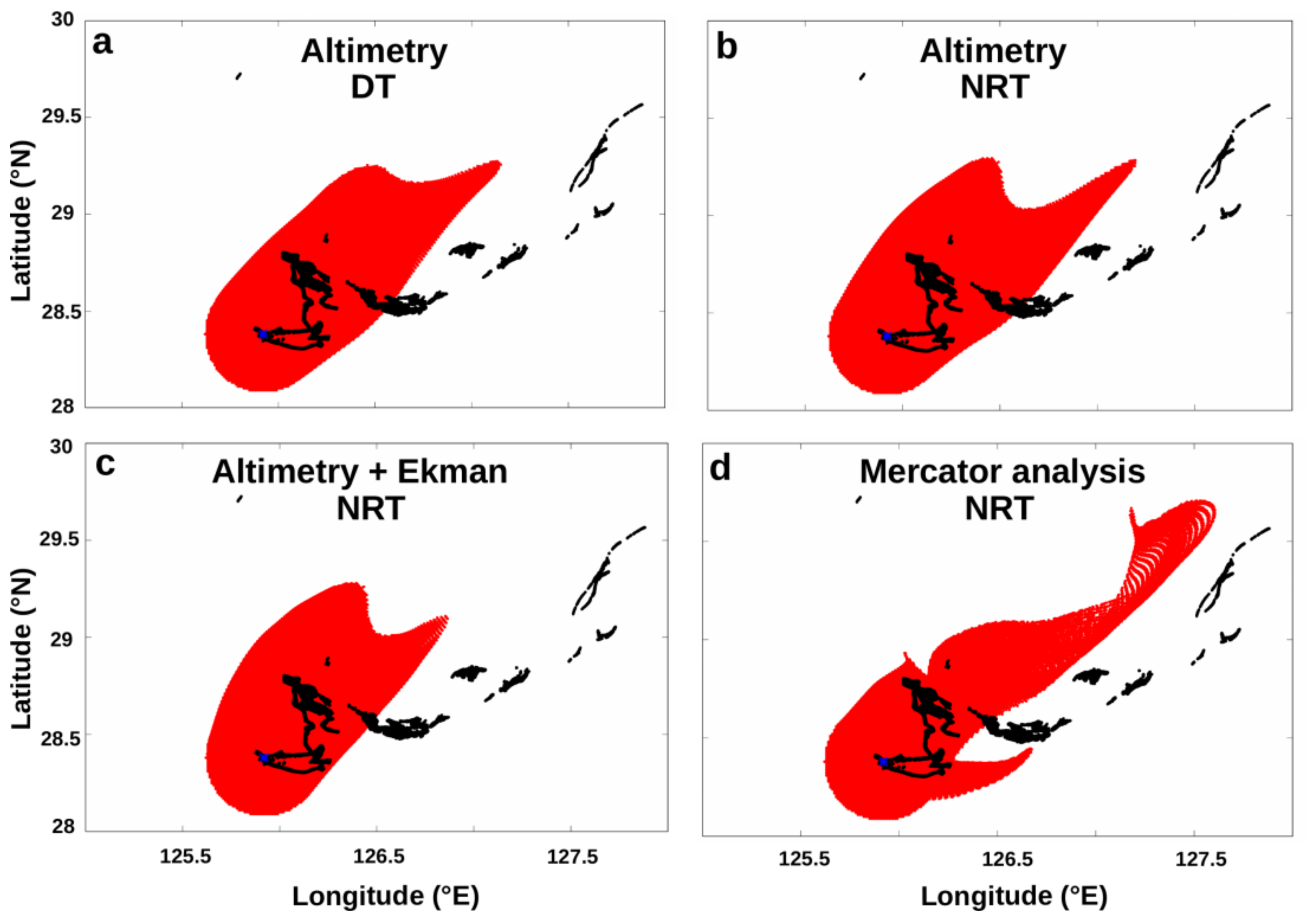


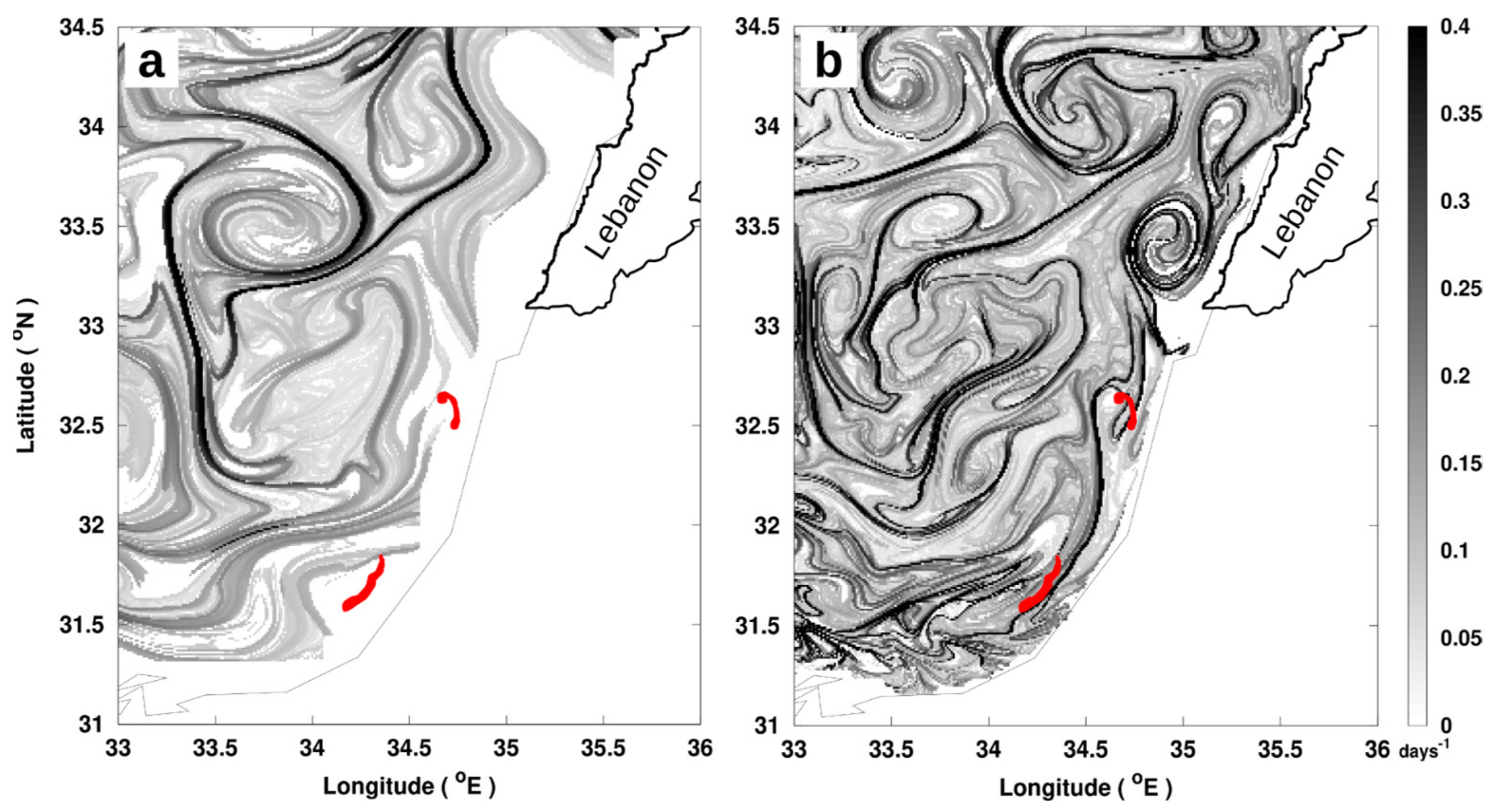

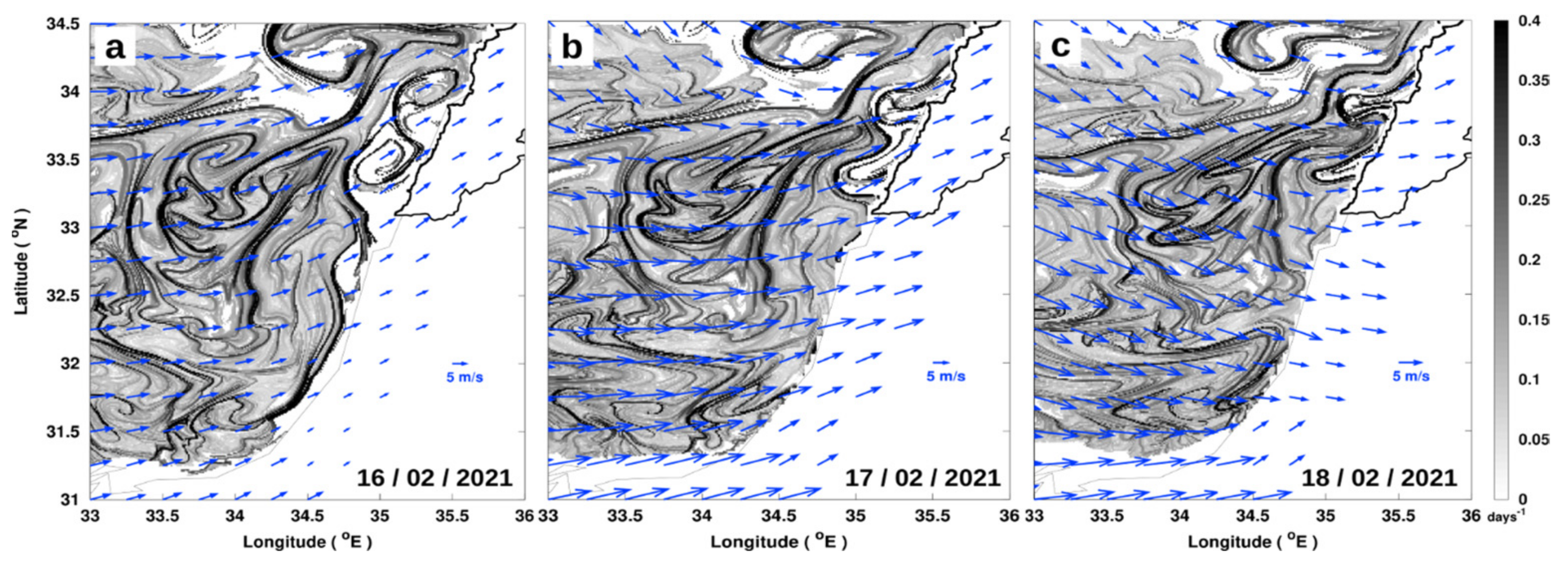
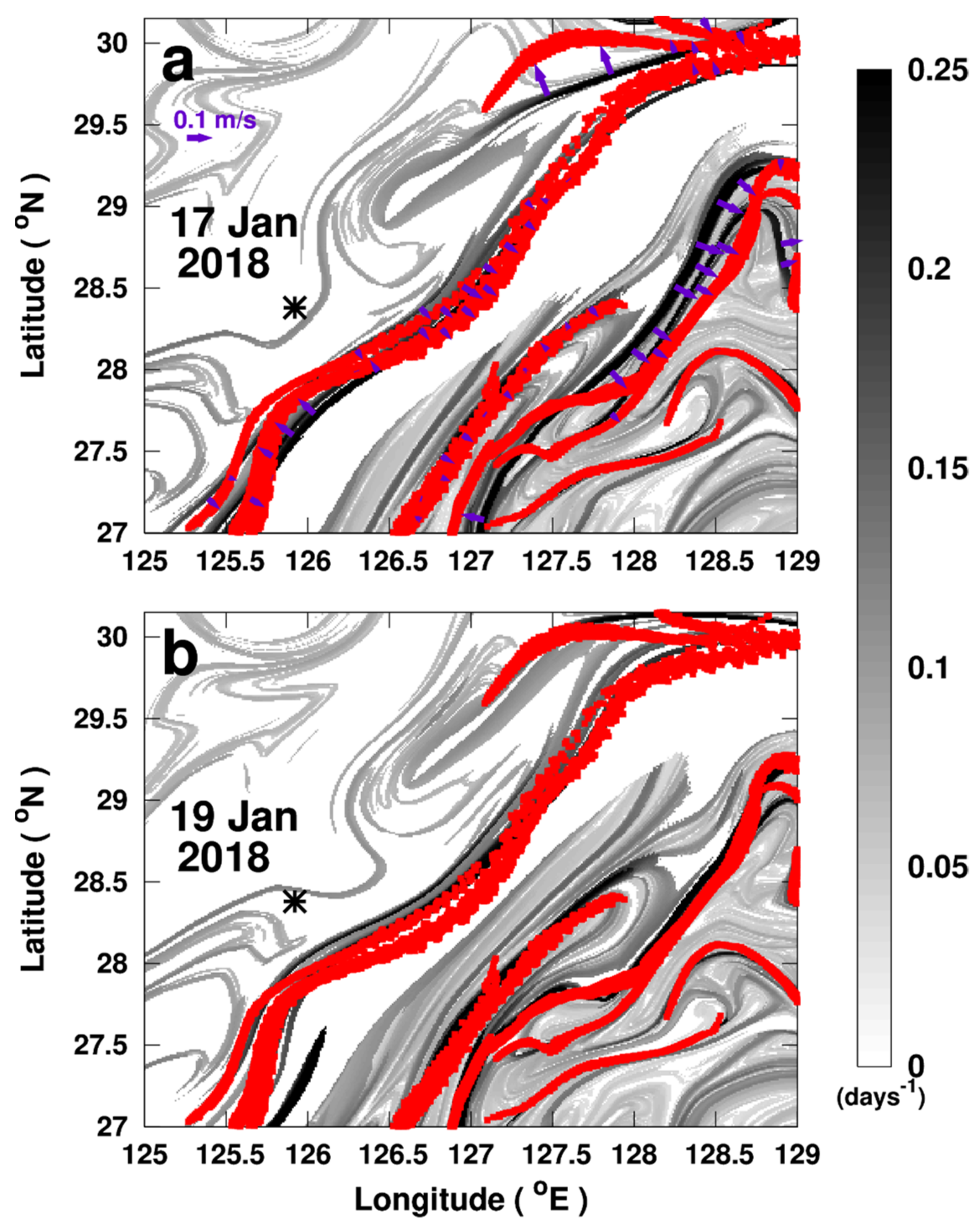
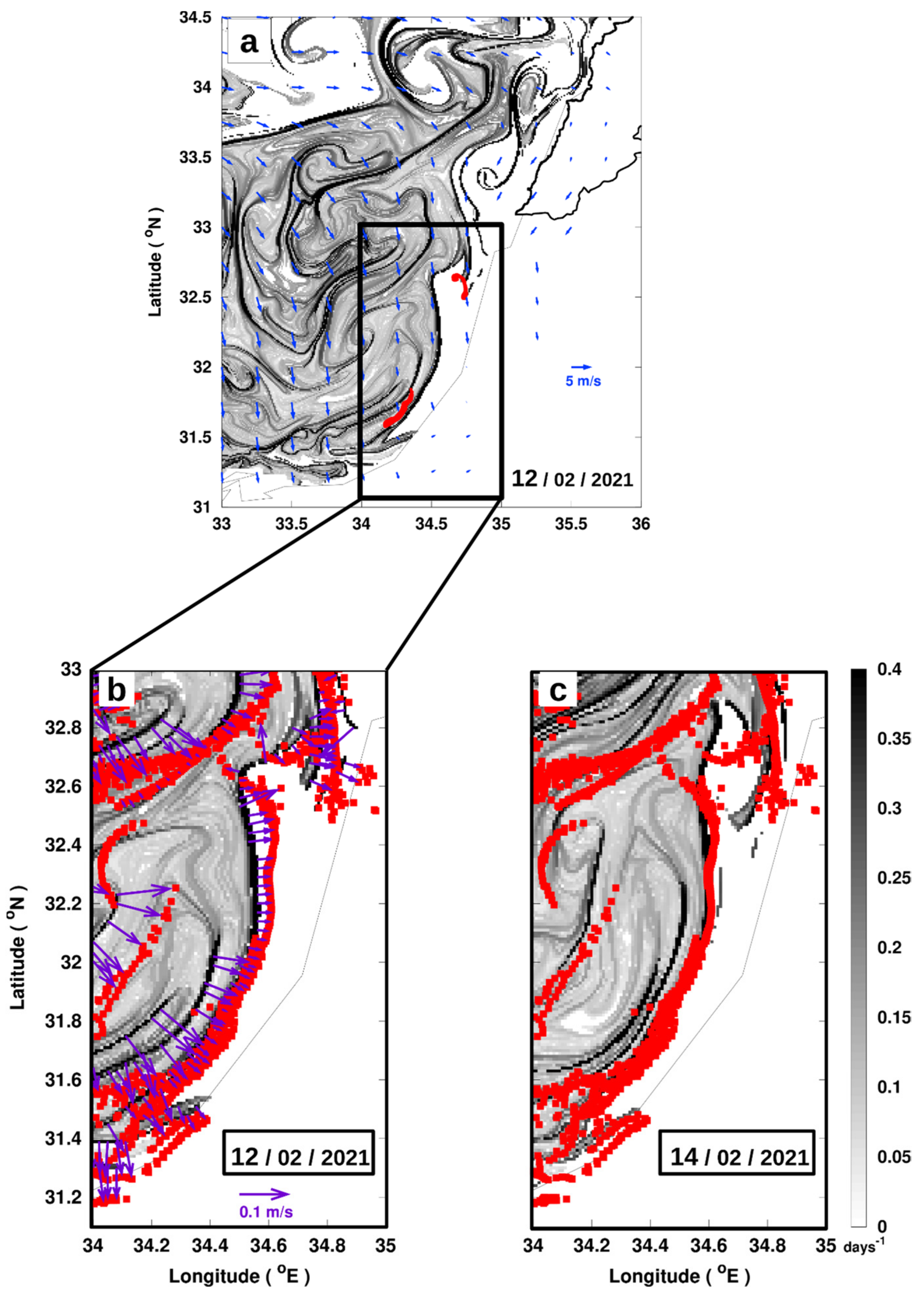

Publisher’s Note: MDPI stays neutral with regard to jurisdictional claims in published maps and institutional affiliations. |
© 2021 by the authors. Licensee MDPI, Basel, Switzerland. This article is an open access article distributed under the terms and conditions of the Creative Commons Attribution (CC BY) license (https://creativecommons.org/licenses/by/4.0/).
Share and Cite
Fifani, G.; Baudena, A.; Fakhri, M.; Baaklini, G.; Faugère, Y.; Morrow, R.; Mortier, L.; d’Ovidio, F. Drifting Speed of Lagrangian Fronts and Oil Spill Dispersal at the Ocean Surface. Remote Sens. 2021, 13, 4499. https://doi.org/10.3390/rs13224499
Fifani G, Baudena A, Fakhri M, Baaklini G, Faugère Y, Morrow R, Mortier L, d’Ovidio F. Drifting Speed of Lagrangian Fronts and Oil Spill Dispersal at the Ocean Surface. Remote Sensing. 2021; 13(22):4499. https://doi.org/10.3390/rs13224499
Chicago/Turabian StyleFifani, Gina, Alberto Baudena, Milad Fakhri, Georges Baaklini, Yannice Faugère, Rosemary Morrow, Laurent Mortier, and Francesco d’Ovidio. 2021. "Drifting Speed of Lagrangian Fronts and Oil Spill Dispersal at the Ocean Surface" Remote Sensing 13, no. 22: 4499. https://doi.org/10.3390/rs13224499
APA StyleFifani, G., Baudena, A., Fakhri, M., Baaklini, G., Faugère, Y., Morrow, R., Mortier, L., & d’Ovidio, F. (2021). Drifting Speed of Lagrangian Fronts and Oil Spill Dispersal at the Ocean Surface. Remote Sensing, 13(22), 4499. https://doi.org/10.3390/rs13224499





